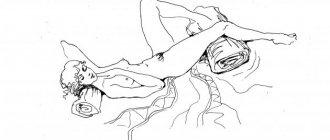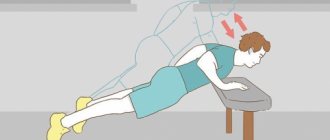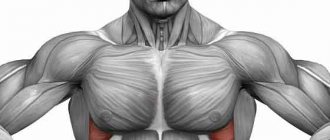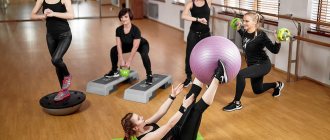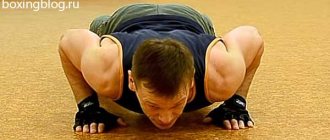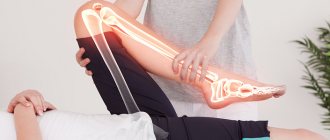Massage and muscle stretching
Massage and muscle stretching can relieve painful tone, improve vascular trophism, speed up metabolic processes in myofibrils, and remove discomfort when walking and sitting. Massage of the piriformis muscle includes several areas:
- Self-massage.
- Rectal massage.
- Stretching and relaxation.
The patient can perform self-massage regularly. No special devices are needed for this. All you need is a flat and hard surface. It is best to perform self-massage movements on the floor.
To eliminate the effects of compression of the sciatic nerve, you need to lie on your side and carefully massage the area of the gluteal muscle with your thumb, trying to pay more attention to painful and compacted areas. The massage will be more effective if the muscle is in a slightly stretched state; for this you need to bend the leg at the knee joint.
Self-massage of the piriformis and other short muscles involved in hip rotation using a tennis ball is carried out on a flat, hard surface (a prerequisite). The patient lies on his side and slides the side surface over the ball. The ball must touch compacted and painful areas; the places where the sciatic nerve passes are avoided so as not to increase its ischemia. Movements should be slow, smooth, sliding and directed downward (in the direction of the muscle fibers). If there is a feeling of numbness or tingling, then the ball has hit the sciatic nerve. In this case, it needs to be moved a little forward. One session includes at least three rolls.
With an active inflammatory process, it is recommended to make circular movements in the hip joint on the affected side while standing. Movements of the torso and arms can be arbitrary. The procedure is repeated every 4-6 hours.
Rectal massage is performed by a specialist. The patient lies on his side, the doctor inserts a finger into the patient’s rectum, finds the area of painful compaction of the piriformis muscle and begins to lightly massage the spasmodic areas. As you massage, the pressure either intensifies or weakens. Rectal massage is a highly effective procedure that allows you to quickly relieve ischemia of muscle fibers and the sciatic nerve.
For stretching and relaxation, exercises are performed by a doctor who controls the strength of turns and pressure. The main condition is that the patient must feel a pleasant tension in the muscles, pain is unacceptable. Exercises are carried out in the hip joint and along the entire length of the leg to the heel bone. The technique is based on overcoming light resistance, stretching inflamed areas and decompression in areas of spasm.
Causes of sprains
The causes of injury can be divided into technical and physiological.
Technical reasons
This is a large group of causes of sprains and tears, which are united by errors in the technique of performing exercises:
- poor warm-up;
- jerks;
- heavy weights;
- excessive number of repetitions.
In first place is a bad warm-up. When muscles are cold, increased stress on them can lead to muscle fiber damage. This is popularly called “stretching”. In the worst case, you can partially tear the muscle.
Theoretically, it is possible to pull any muscle. But the most vulnerable are the deltoids, biceps, back and back, inner thighs. The shoulders are included in this group due to the “unfortunate” location of the tendons, which are subject to friction during movement. Therefore, training the shoulder muscles without pre-warming up can quickly lead to muscle damage. Thus, the muscles on the shoulders are more likely to be pulled than on the leg. And sometimes abdominal muscle strains occur.
During the jerk, you risk tearing tendons and ligaments. If you can't lift the weight smoothly, don't cheat. Instead, ask a friend to help you on the lift and do negative reps with that weight. The benefits from this will be much greater.
Another problem associated with the technical side of performing exercises is lifting heavy weights. Situations are especially dangerous when beginners are learning their strength abilities.
Their muscles are not yet accustomed to high loads, and their technique is not yet ideal. In such a situation, when lifting maximum weights, of course, there is a high risk of getting a sprain. If a beginner immediately grabs a 25 kg weight plate and starts doing body lifts, then even though the abdominal muscles are strong, you can stretch them. Doing a squat with the wrong technique can lead to a strained thigh muscle, and so on.
Treatment methods
After making a final diagnosis, the doctor prescribes treatment. As a rule, it is complex and consists of several components:
- Drug therapy.
- Massage.
- Manual therapy.
- Physiotherapeutic treatment.
- Reflexology.
- Physiotherapy.
- Corrective treatment (insoles, buttock pads, etc.).
Drug treatment:
- Anti-inflammatory drugs. The basis of drug therapy is drugs from the group of anti-inflammatory non-steroidal drugs. The most effective drugs based on diclofenac have proven themselves - Voltaren, Dikloberl, Diklo-F, Meloxicam, Ketanov, etc. Depending on the degree of development of the disease, they are prescribed orally or intramuscularly. The course of treatment is at least 10 days, 2 injections of the drug are given daily with a period of 6 hours.
- If the patient is in pain, painkillers and antispasmodics are prescribed. They relieve muscle spasms well, reduce pressure on the sciatic nerve and surrounding vessels. Suitable painkillers include: Baralgin, Tempalgin, Sedalgin, etc. The most commonly used antispasmodics are No-Shpa, which is administered intramuscularly along with anti-inflammatory drugs.
- If the inflammatory process is complicated by bone deformation, then antispasmodics cannot fully relieve the painful spasm. In this case, muscle relaxants are prescribed. They effectively relieve tone from inflamed muscles, freeing pinched nerves and blood vessels. Most often, doctors prescribe Mydocalm.
- Drug therapy may include drug blockades. When inflamed, the piriformis muscle becomes painfully stretched and compressed, and the roots of the sacral region are involved in the process. The task of the novocaine blockade is to remove spasm and tension from these pelvic structures. The doctor marks the points of the ischial tuberosity, ilium and greater trochanter, connects these marks and determines the area of drug administration. Then he inserts the syringe needle to a depth of 6-8 cm and slowly releases novocaine into the space between the muscle body and the sacral root. The adult dose for blockade is 10 ml.
Pathologies of the piriformis muscle are quite difficult and lengthy to treat. Therefore, the drug course is repeated at least 2 times a year during seasonal exacerbations.
What to do if you pulled a muscle
How to tell if you have a sprain
First, let's figure out how to understand that you have pulled a muscle. A sprain may appear during training - at one point you will feel a sharp pain. The severity of the pain will directly depend on the severity of the injury. Minor sprains may not interfere with your ability to work. Severe injuries will cause hellish pain, through which you will not be able to get over without pain relief.
In some cases, pain occurs after sprains. For example, today you were playing table tennis and slipped, almost doing the splits (despite the fact that you cannot sit on it). As long as you continue playing, there is no pain. At home, after you have not moved for a while, you will feel a sharp pain somewhere in the back or outer part of your thigh. This is delayed pain.
A few hours after the pain, when examining the injury site, swelling and redness can be detected. The next day, a small bruise (blue-yellow) may form in that area. If these signs appear, you definitely have a sprain.
Don't confuse sprains with tears and fractures. For example, when your foot suddenly falls into a small hole while walking, you put your foot on one side. The muscles do not have time to fix the position of the leg, as a result of which the entire load is transferred to the ligaments. Naturally, they can tear. In this case, the leg in the ankle area will swell on both sides. In a day or two, a large bruise will appear. In this case, there may be either a rupture or a crack in the bone.
What to do if this happens
What to do if you pulled a muscle? Stop exercising as soon as you feel pain. It is better not to finish training on this day - you need to return home and rest. Depending on the extent of the injury, the pain may subside within 3 days. Or maybe he will stay with you for several weeks.
Your task is not to exercise through pain. You need to drive blood, but without using the sore muscle.
The first thing to do after an injury is to stop exercising and rest the muscle for at least a week. For example, if you have pulled your thigh muscles, avoid putting stress on your legs and walk carefully so that you don’t feel pain.
You can come to your next workout, but do not do exercises that involve the sore muscle.
If your abdominal muscles hurt, put on a woolen bandage and try not to laugh. This happens extremely rarely, but it does happen. Often, when working the abdominal muscles (especially when lifting the legs), the upper front part of the thigh may become sore. This interferes with any work with the press.
When the muscles in your leg are pulled, avoid running, jumping, squats and all exercises that involve your legs. Wait a week, then start training.
If you have severe pain, we recommend using topical pain-relieving ointments. Keep in mind that pain is a sign of injury. If you don't feel it, you may harm yourself even more.
If the pain does not go away after a week of rest, contact a traumatologist. After the examination, he may prescribe physical therapy for you.
Piriformis syndrome treatment
Once the diagnosis is confirmed, the question arises of how to treat piriformis syndrome. The main recommendation is an integrated approach to solving the problem. The doctor’s task is to identify and eliminate the main provocateur of the disease. The prognosis for the disease is favorable if the correct therapy is prescribed in a timely manner. The condition can be cured with just a few sessions of massage, post-isometric relaxation (PIR) and special exercises. As a rule, doctors do not prescribe medications. But you can relieve pain and relieve spasms with the help of:
- analgesics (Analgin, Pentalgin, Spazmalgon);
- NSAIDs – tablets and ointments (Ketanov, Ketorol, Ibuprofen);
- antispasmodics (No-Shpa);
- muscle relaxants (Prenderol, Baclofen).
Massage for piriformis syndrome
If the culprit of the syndrome is a spasm, it must be stopped. Massage of the piriformis muscle is designed to soothe and relax the affected area. Manipulations are aimed at the gluteal-sacral region. To reach and massage the required muscle, you can use a tennis ball or a special roller. You need to sit on it, find the pain point and stay in this position for a while.
Exercise therapy for piriformis syndrome
After massage and deep pressing of the affected muscles, it is necessary to consolidate the result obtained, improve their stretching and blood supply. Charging successfully accomplishes this goal. Stretching, running exercises and gymnastics for piriformis syndrome help strengthen muscles. In some cases, home exercises relieve illness and completely replace drug and other therapy.
When piriformis syndrome is diagnosed, exercises must be performed with caution, exercise responsibly, gradually, and avoid severe pain during exercise. Types of some exercises:
- With an expander. Stand with your healthy leg against the wall (sideways), attach the expander to the affected limb, and the other end to another stationary object. Secure it at ankle level. Take the leg to the side, return to the starting position, do 10-15 repetitions and two approaches.
- Sitting on the mat, bend one leg and then slowly bend the other, placing the heel towards the opposite knee. Unpleasant sensations in the knee joint must be avoided and move slowly. Place your palms behind your back and move towards the second leg with your chest.
- Side plank. Lying on your side, line up your shoulders, shins and hips. Raise your hips off the floor, balancing on one elbow, and try to hold the position for 10-15 seconds. Slowly lower your hips to the floor. Repeat on the other side.
- Complete relaxation. You need to lie on your back, stretch your limbs along your body, and monitor your breathing.
https://youtube.com/watch?v=4Dzn5OtG1Hc%250D
Physiotherapy for Piriformis Syndrome
Some physical therapy procedures help relax muscles, relieve spasms and stop inflammation. They are successfully combined with medication and massage. Diadynamometry (exposure to diadynamic currents) and magnetic laser therapy provide good results. To eliminate piriformis syndrome, treatment with heat, cold, shock, etc. the doctor selects. In addition to those presented, the following methods are practiced:
- laser therapy;
- ultrasound;
- phonophoresis;
- vacuum massage;
- UHF therapy;
- paraffin applications;
- amplipulse
https://youtube.com/watch?v=-jDSkDr5lC8%250D
Whatever method is chosen, it is important to follow the chosen treatment path and, if necessary, supplement it with medication. Piriformis syndrome rarely requires serious intervention, only when it is caused by injury and tumors
The pathology can be successfully combated at home under the supervision of a doctor.
Signs of sciatic nerve compression
This disease always occurs acutely, so it is difficult not to notice when the piriformis muscle is irritated. Everyone needs to know how to relieve a spasm, the symptoms of which are characterized by severe pain. After all, compression of nerve endings and blood vessels leads to disruption of blood supply to tissues, as well as to neurological disorders.
Piriformis syndrome can present itself in different ways. When inflammation occurs that affects a nerve, the following symptoms typically occur:
- Paresthesia (tingling, numbness and crawling).
- Severe pain in the area of the gluteal muscle, thigh, pelvis, passing in some cases to the lower extremities.
- Hypesthesia (decreased sensitivity).
- Disorders of the functions of the genital organs and urination.
- Gait disturbance.
You need to be aware of what to do if the piriformis muscle is tense, how to relieve spasm when the first signs of the disease occur. With severe inflammation, a person experiences unbearable pain, the nature of which can be aching, burning or dull. Moreover, they begin to intensify with stress, overheating and movement of the limb.
When a nerve is pinched for a long time, its ischemia occurs, which causes loss of sensitivity, burning and deterioration of reflexes. In this case, the unpleasant sensations become dull and oppressive. The discomfort goes away only when the legs are spread apart, when the nerve is released from the pressure. When blood vessels are damaged, coldness and paleness of the skin occurs.
Treatment of the syndrome
The treatment algorithm for this syndrome is similar to the elimination of pain that is associated with compression of the sciatic nerve, as well as the nerve roots of the lumbosacral spine. Piriformis syndrome should not be considered as a local manifestation of pain. The treatment provided should be aimed not only at improving the patient’s well-being, but also at eliminating the causes that provoked the development of this pathology.
In case of severe pain, medical specialists prescribe drug therapy using painkillers and antispasmodics. However, the most effective type of treatment for piriformis muscle syndrome includes several of the following techniques simultaneously:
- laser puncture;
- pharmacopuncture;
- massotherapy;
- Exercise therapy and special exercises;
- acupuncture;
- physiotherapy;
- vacuum therapy.
An integrated and systematic approach to the treatment of this syndrome allows you to eliminate it in a short time, forever forgetting about discomfort and pain.
The role of massage in the treatment of disease
Along with medications, doctors prescribe a course of therapeutic massage for piriformis syndrome. This treatment method is most effective in the early stages of the disease. The massage begins with kneading the paravertebral area, followed by moving to the lumbosacral area
It is important to remember that such exposure may not always lead to a positive effect, therefore such procedures should be performed under the supervision of the attending physician
Immediately massage the buttocks on the sore side, then proceed to the back of the leg. Its average duration varies between 15-20 minutes. For a visible improvement in the condition, it is recommended to carry out 12 to 20 massage procedures, and after a month repeat this course again.
Treatment with reflex-segmental or acupressure massage promotes a speedy recovery of the patient and eliminates pain. As a conclusion, massage is an excellent complement to basic medical therapy.
Physiotherapy
Exercise therapy or gymnastic exercises are an integral part of the treatment of this disease. They effectively reduce pain, relax muscle tissue and significantly improve the patient’s well-being. Exercise therapy can also be done at home after first learning how to perform the exercises correctly. Remember, to avoid injury, exercises should be done carefully, not at full strength, and not to cause pain.
Let's look at a few universal exercises:
- Exercise No. 1. Lie on your back on a hard surface, bend your knees, place your feet shoulder-width apart. Slowly bring your knees in and out as you count. You should spread your knees as far as is painless for you.
- Exercise No. 2. Lying on your back, place your feet on the floor, bend your knees, and bring your feet and knees together. Slowly and smoothly bend your knees to one side, then to the other.
- Exercise No. 3. Get on all fours. Bend the affected leg at the knee, move it to the side, and then carefully straighten it, return the leg to its original position in the reverse order. Repeat similar steps for the other leg.
- Exercise No. 4. Sit on a chair so that your body and legs form 90-degree angles, place your sore leg on your healthy knee. Slowly, without hunching your back, bend your body forward towards your knees.
Exercise therapy and massage in combination with taking medications is the most effective way to treat this pathology. But do not forget that in order to avoid the opposite effect, all procedures must be previously agreed upon with the attending physician.
Symptoms
Did you know that...
Next fact
Spasm of the piriformis muscle is usually very acute, so it is easy to notice. Therefore, the main symptom is usually severe pain.
In addition, the following signs of pathology may appear::
- Local , which are directly related to the spasm itself.
- Neuropathic , caused by compression of the sciatic nerve. This includes sciatica, autonomic and motor disorders in the lower extremities from the location of this muscle.
- Vascular symptoms , which are caused by compression of the artery of the buttocks and other vessels passing through this hole.
Symptoms of this disease also include paresis in the muscles of the foot and leg. In some cases, intermittent claudication appears. Dysfunction of the rectal and urethral sphincter may occur.
Diagnostics
To determine the development of spasm of the piriformis muscle, the specialist first uses the palpation method. In this way, he determines whether there are any compactions in the muscle tissue.
During a general examination, the doctor checks for pain in the following positions::
- when rotating the leg inward with the bent hip;
- while raising the knee from a lying position on the healthy side;
- during flexion, adduction and internal rotation of the hip;
- when slowly bending forward from a standing position on straight legs;
- with a light tap on the buttock.
X-rays, novocaine blockade, magnetic resonance or computed tomography can also be used in diagnosis.
Health and rehabilitation system of Professor Bubnovsky
The famous doctor, Doctor of Medical Sciences, Professor S. M. Bubnovsky is the author of several unique techniques that help cure many pathologies of the musculoskeletal and muscular system, as well as restore their lost functions.
Kinesitherapy by Bubnovsky includes:
- Assessment of the condition of the skeletal and muscular systems, which allows you to determine the exact localization of the inflammatory process and prescribe treatment based on the nature of the disease, the individual characteristics of the patient and concomitant diseases.
- Treatment on special simulators at Dr. Bubnovsky’s centers. A course is selected for the patient and the maximum payload is determined. Treatment using simulators eliminates radicular syndrome of inflamed muscles, relieves pain and discomfort, and restores joint mobility.
- A special course of therapeutic exercises that can be performed quite successfully at home. Let's look at it in more detail.
Gymnastics from Professor Bubnovsky:
Get on all fours. Relax your back and hold the position for 5 seconds. Repeat 5-6 times. In a position on all fours, bend your back as you inhale, and as you exhale, slowly arch your back until you feel a stretch in the muscles. Perform 20 times. In a position on all fours, sit on your left leg, take your right leg back, fix your step, extending your left arm forward. Slowly change legs, moving forward with such stretching steps, not forgetting to change outstretched arms. Do 20 exercises. In a position on all fours, fix your position with your knees and palms towards the floor. Pull your body forward without lifting your knees and palms from the floor. Make sure that your lower back does not bend. In a position on all fours, bend your arms at the elbow joint, and while exhaling, lower your buttocks onto your heels, trying to stretch the lumbar muscles. Inhale and as you exhale return to the starting position. Repeat 6 times. Lie on your back, put your hands behind your head, bend your knees. Inhale and as you exhale, press your chin to your chest, lift your shoulder blades off the floor and touch your elbows to your knees
It is important that the abdominal muscles are tense until a burning sensation appears. Repeat 5 times. Lie on your back, stretch your arms along your body, while exhaling, try to lift your pelvis off the floor as much as possible, and while inhaling, lower yourself back
Perform from 10 to 30 times.
The complex should be mastered gradually, adding a new exercise every day. Try to do everything with full dedication and good stretching.
Gluteus muscle injury
Unexplained pain in the soft tissues of a person's body is almost always due to muscle injury. It is these tissues that are susceptible to stretching, tearing and other damage, since they are elastic and designed to ensure human motor activity. If a muscle is injured, it cannot perform its tasks normally.
, injuries to the gluteal muscle are common . This is a damage that is quite difficult to treat. It is simply impossible to immobilize this area of the musculoskeletal system. The person cannot sit or lie normally, severe pain prevents him from walking normally. Therefore, recovery from such damage is often long and difficult.
Comments
(function(w, d, n, s, t) { w = w || []; w.push(function() { Ya.Context.AdvManager.render({ blockId: 'RA-324974-4', renderTo : 'yandex_rtb_R-A-324974-4', async: true }); }); t = d.getElementsByTagName('script'); s = d.createElement('script'); s.type = 'text/javascript '; s.src = '//an.yandex.ru/system/context.js'; s.async = true; t.parentNode.insertBefore(s, t); })(this, this.document, 'yandexContextAsyncCallbacks ');»+»ipt>
"+"ipt> (adsbygoogle = window.adsbygoogle || []).push({});"+"ipt>
- Automatic gates
- Wooden gates and fences
- Hedge
- Brick fences
- Fence and gate structures
- Metal fences and gates
- Fence and gate installation
- Answers on questions
- Finishing the fence and gate
- Fence and gate repair
- Advertising on the website
- Our specialists
Features of treatment and prevention of muscle injuries
Muscles can be healed with modern medical treatments. Simple bandages and bandages do not work in the case of the gluteal muscle, since they cannot be secured. Kinesio tapes allow you to reliably immobilize a specific area of the musculoskeletal system and obtain optimal conditions for recovery. The patient receives several tangible benefits from the treatment process:
- you can restore a muscle much faster, since kinesio tape blocks its activity and leaves it calm;
- there is no need to endure pain for the first few days, the pad neutralizes movements for this muscle;
- You don’t feel the tape being worn within an hour after application, there is no discomfort;
- You can wear tapes around the clock, there is no need to remove them even at night, the blood flow is not pinched;
- the cost of such bandages is much lower than traditional bandages, given the period of use.
The use of modern tapes to treat muscle problems is relevant not only for sports. Advanced traumatologists are beginning to use these bandages to treat patients in clinics. You can independently obtain information about taping muscles in the gluteal area. Today this is the only reasonable method of immobilizing muscle tissue in such inconvenient places for treatment.
Exercises for good health
Even with pain, they can return, so to significantly improve the condition and maintain health, there are special gymnastics for pinched piriformis muscle.
The exercises are usually static, aimed at eliminating inflammation, and involve slight stretching followed by relaxation. They are done every day, you can do it at home, but first receive training from an experienced physical therapy doctor.
Before starting, do a 10-minute light voluntary warm-up (lying or standing), making movements in the lower back and hip joints that do not cause discomfort. If possible, lightly massage your lower back, buttocks, and back of the thigh.
To avoid injuring yourself, perform the movements slowly, carefully, without causing pain, and to begin with, the number of repetitions should not go beyond what is comfortable for you.
If unpleasant sensations arise, do not stop the activity or shorten its time - just reduce the amplitude and apply less effort.
Here are gymnastic exercises recommended to relax the piriformis muscle.
- Lying on a hard surface on your back. Legs bent, feet shoulder-width apart. Slowly open your knees as far as you can, then bring them together.
- Same position, feet and knees together. Gently bend your knees towards the floor from side to side.
- Same position with straight legs. Raise your left leg at a right angle to your body and move it to the right, trying to touch the floor with your toe. Relax, feel the tension in the muscle. Try not to rotate your pelvis. Repeat with the other leg. (If your knee is difficult to straighten, you can bend it.)
- Position - on a chair, with a straight back, legs bent at a right angle. Place the ankle of your affected leg on your other knee. Without bending your back, slowly lean forward towards your knees. (The same can be done standing, placing your bent leg, for example, on a table.)
Therapeutic gymnastics is simple, but very effective, especially in combination with other methods recommended by a specialist. It can solve almost 80% of the problems of the entire treatment, not to mention saving money and time.
The only condition is to strictly follow the doctor’s prescriptions so as not to get the opposite effect. And then the improvement in well-being will not be long in coming.
By the way, if you want to get a step-by-step plan for treating a pinched sciatic nerve, then go to this page right now.
There you will find a free training course that will help you get rid of this problem once and for all at home.
Denial of responsibility
The information in the articles is for general information purposes only and should not be used for self-diagnosis of health problems or for therapeutic purposes. This article is not a substitute for medical advice from a doctor (neurologist, therapist). Please consult your doctor first to know the exact cause of your health problem.
I will be very grateful to you if you click on one of the buttons and share this material with your friends
